Explore the mighty Mississippi River and uncover the rich history of Minneapolis on this private walking tour. Venture through the iconic Mill Ruins Park, marvel at the dramatic St. Anthony Falls, and learn about the city’s profound relationship with the river. Guided by a knowledgeable local, this 2-hour experience offers a personalized look into the architecture, industry, and culture shaped by the river’s influence. From the remnants of the nation’s first hydropower plant to the striking Stone Arch Bridge, this tour promises to reveal the profound impact the Mississippi has had on shaping the city. What secrets will you uncover?
Key Points
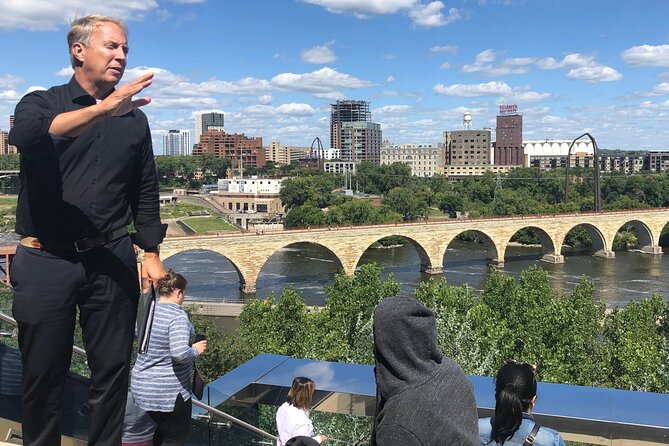
- Explore the historic Mill Ruins Park along the Mississippi River, including the dramatic St. Anthony Falls and the iconic Stone Arch Bridge.
- Discover the history of the nation’s first hydropower plant and its role in powering the region’s industries.
- Enjoy a 2-hour private walking tour with a knowledgeable guide to learn about the river’s significance and the area’s distinct architecture and culture.
- The tour starts and ends at the convenient Stone Arch Parking Lot in Mill Ruins Park, with ample parking available.
- Experience the outdoor museum-like setting of Mill Ruins Park, which showcases the towering stone remnants of former mills and the river’s role in powering industry.
Minneapolis-Saint Paul Overview

Minneapolis-Saint Paul, a vibrant metropolitan area in the heart of the Midwest, boasts a rich history intertwined with the mighty Mississippi River, which has played a pivotal role in shaping the region’s development.
The two cities, often referred to as the ‘Twin Cities,’ have long been shaped by their proximity to the river, which has provided transportation, power, and a source of recreation for the local population.
From the early settlements to the present day, the Mississippi River has been a constant presence, influencing the architecture, industry, and culture of this dynamic urban center.
Visitors to the area can explore the river’s significance through various landmarks and historic sites, gaining a deeper appreciation for the region’s unique identity.
If you're enjoying exploring Minneapolis Saint Paul on foot, you'll love these other walking tours we recommend
Tour Highlights

The walking tour highlights the connection between Minneapolis and the mighty Mississippi River, allowing visitors to explore the area’s rich history and stunning natural landscapes.
Guests will venture through Mill Ruins Park, gaze upon the dramatic St. Anthony Falls, and cross the iconic Stone Arch Bridge, all while learning about the region’s early settlement and the pivotal role the river has played in shaping the city.
They’ll uncover the history of the nation’s first hydropower plant and gain insider tips on the best places to eat, drink, and further explore the vibrant Mill District.
Throughout the personalized 2-hour tour, the knowledgeable guide will bring the past to life, offering a truly immersive experience for all.
Tour Details
This private walking tour lasts for 2 hours and offers a personalized experience for guests.
Guests will meet at the Stone Arch Parking Lot in Mill Ruins Park, located at 100 W. River Parkway in Minneapolis, MN 55401. The tour will end back at the meeting point.
Visitors should confirm the exact start time with the local provider in advance, as the tour is open daily from 8 AM to 4 PM.
Throughout the experience, a private guide will lead guests on a journey along the Mississippi River, introducing them to the area’s rich history and iconic landmarks.
Gratuities are included, ensuring a seamless and enjoyable tour for all.
Meeting and End Point
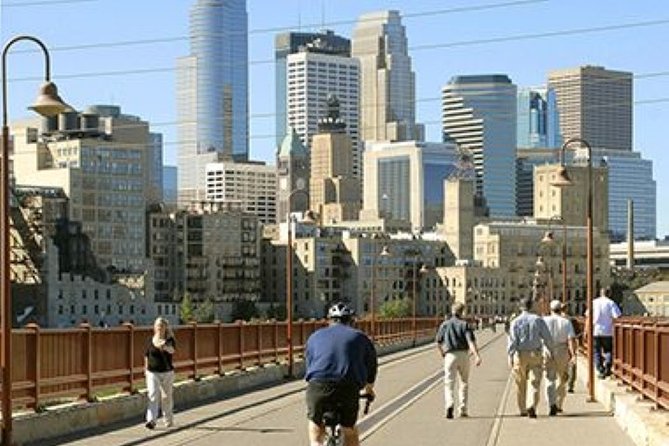
The meeting point for this private walking tour is the Stone Arch Parking Lot in Mill Ruins Park, located at 100 W. River Parkway in Minneapolis, MN 55401.
Guests will start and end the 2-hour experience at this central location. The tour provider advises confirming the exact start time in advance, as the tour is open daily from 8 AM to 4 PM.
Some key details about the meeting and end point include:
- Convenient access to the historic Stone Arch Bridge and Mill District
- Ample parking available at the Stone Arch Parking Lot
- Easy return to the starting point at the conclusion of the tour
Exploring Mill Ruins Park
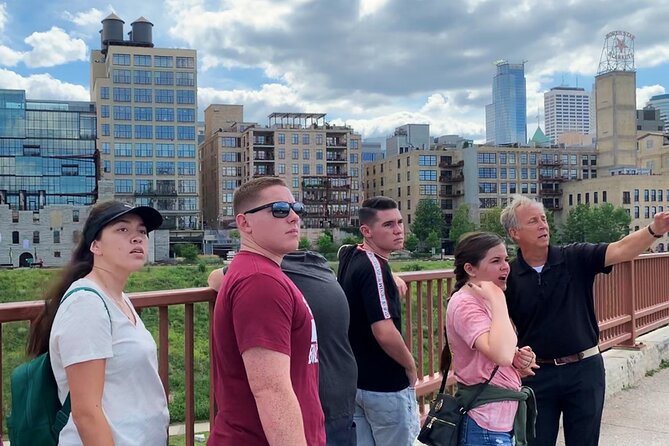
Visitors explore Minneapolis’ rich history as they meander through Mill Ruins Park, where the remnants of the city’s once-thriving milling industry stand as testament to its industrial past. This outdoor museum-like setting offers a glimpse into the pivotal role the Mississippi River played in the city’s development, as towering stone ruins and remnants of the iconic Stone Arch Bridge reveal the scale and power that once defined the area. Guests can explore the foundations of former mills, learn about hydropower’s early impact, and marvel at the engineering feats that propelled Minneapolis’ growth.
| Key Feature | Description |
|---|---|
| Ruins | Towering stone remnants of former mills |
| Stone Arch Bridge | Historic bridge showcasing engineering achievements |
| Hydropower | Evidence of the river’s pivotal role in powering industry |
| Outdoor Museum | An immersive way to experience Minneapolis’ industrial past |
Want to keep it personal? More private experiences we love in Minneapolis Saint Paul
- Walking St. Paul Summit Ave. Victorian Homes Private Tour (2 Hrs)
- Walking F. Scott Fitzgeralds St. Paul Life & Homes Private Tour (2 Hrs)
- Crooked St. Paul Gangsters Private Riding Tour (2 Hrs)
- Private Departure Transfer to Minneapolis Airport MSP
- Historic Minneapolis Riverfront Private Walking Tour
- Minneapolis Airport (MSP) to Minneapolis – Round-Trip Private Transfer
Discovering the Stone Arch Bridge
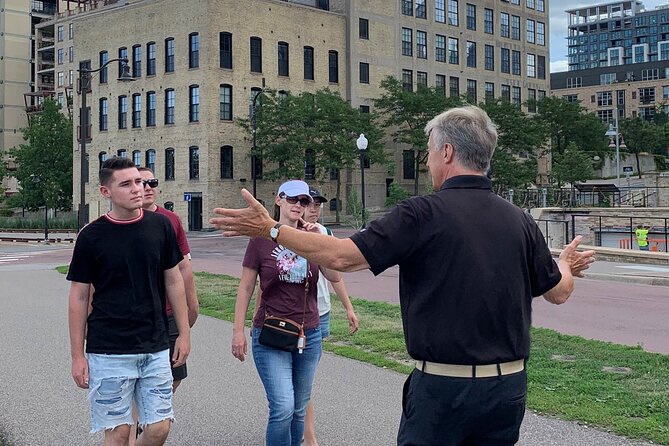
As visitors cross the iconic Stone Arch Bridge, they’re struck by the stunning views of the Mississippi River and the dramatic St. Anthony Falls below. This former railroad bridge, built in 1883, now serves as a pedestrian and bike crossing, offering unparalleled vantage points of the city’s rich industrial heritage.
The bridge’s unique arched design and striking red brickwork make it a beloved local landmark. Visitors can:
- Admire the intricate architectural details that have stood the test of time
- Gaze out over the powerful river and cascading falls, a testament to the city’s hydropower history
Visitors can also explore the nearby Mill District, home to converted warehouses and trendy eateries.
This picturesque crossing provides a perfect introduction to the natural and man-made wonders that define Minneapolis’ riverfront.
Learning About the Mill District
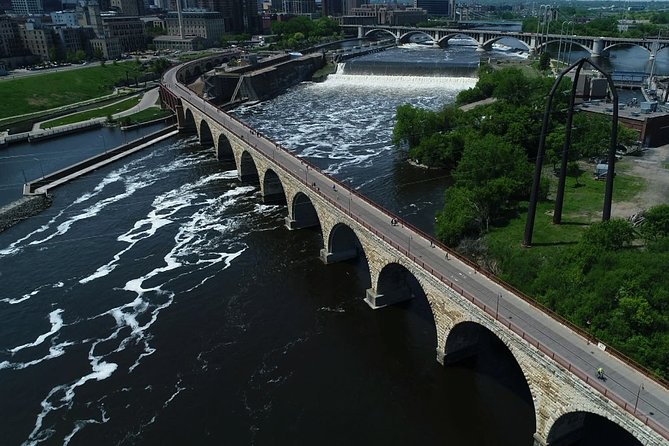
Across the Stone Arch Bridge lies the historic Mill District, where visitors can explore the remnants of Minneapolis’ industrial past.
Once the epicenter of flour production, the area is now home to a vibrant arts and entertainment scene.
The guide will point out the iconic Mill Ruins Park, where the crumbling foundations of old mills stand as a testament to the city’s milling heritage.
Guests will learn how the Mississippi River‘s power was harnessed to grind wheat into flour, fueling the local economy.
The tour also highlights the Washburn ‘A’ Mill, which was once the largest flour mill in the world.
Today, the district’s charming streets, galleries, and eateries offer a unique window into Minneapolis’ industrial legacy.
Uncovering the River’s History
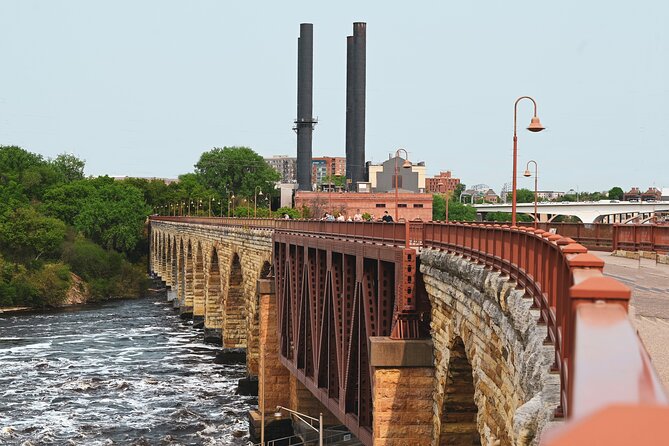
The guide now turns the group’s attention to the river’s history, unpacking how it shaped Minneapolis’ development from its early settlement days.
They learn that the mighty Mississippi has been a vital resource for the city since its inception, powering the industrialization that drove its growth in the 19th century.
The guide highlights:
-
The construction of the first hydroelectric plant in the US at St. Anthony Falls in 1882, which harnessed the river’s power to fuel the city’s mills and factories
-
How the river’s navigability allowed Minneapolis to become a major transportation hub, with goods and materials moving in and out by barge
-
The river’s role in attracting settlers and businesses, as the availability of water power and transportation transformed the area into a thriving commercial center.
Frequently Asked Questions
Can I Take Photos During the Tour?
Yes, guests are welcome to take photos during the tour. The private guide encourages capturing the scenic views and historic landmarks along the way to commemorate the experience.
Are There Any Public Restrooms Along the Tour Route?
There are typically public restrooms available along the Mississippi River trails and in the various parks in the area. Guests can check with the tour guide for the nearest restroom locations during the tour.
What Is the Weather Like During the Tour?
The weather during the tour can vary depending on the time of year. Typically, the area experiences mild temperatures and low precipitation, making it pleasant for walking. Visitors should check the forecast and dress accordingly to ensure a comfortable experience.
Is the Tour Wheelchair Accessible?
The tour is wheelchair accessible, as it takes place along paved pathways and sidewalks. The local provider can accommodate guests with mobility needs, so they can fully experience the sights and history along the Mississippi River.
Can I Bring My Pet on the Tour?
Unfortunately, the tour does not allow pets to accompany participants. The tour focuses on the Minneapolis-Saint Paul area and its connection to the Mississippi River, and the provider’s policies prohibit bringing any animals besides service animals on the walking tour.
Recap
This private walking tour provides a captivating glimpse into the symbiotic relationship between Minneapolis and the mighty Mississippi River.
Visitors will explore the iconic Stone Arch Bridge, marvel at the dramatic St. Anthony Falls, and discover the remnants of the nation’s first hydropower plant, all while learning about the river’s profound influence on the city’s architecture, industry, and culture from a knowledgeable local guide.
More Private Tours in Minneapolis Saint Paul
More Walking Tours in Minneapolis Saint Paul
More Tour Reviews in Minneapolis Saint Paul
Not for you? Here's more things to do in Minneapolis Saint Paul we have recnetly reviewed
- Best Cruises And Boat Tours In Minneapolis Saint Paul
- Best Food Tours In Minneapolis Saint Paul
- 3 Best Private Car With Driver Services In Minneapolis Saint Paul
- Scavenger Hunt in Minneapolis by Operation City Quest
- Minnesota Twins Baseball Game Ticket at Target Field
- Twilight Whispers: A Romantic Stroll Through Minneapolis
- Minneapolis Bar Hunt: Double Your Fun in the Twin Cities
- Fun City Scavenger Hunt in Saint Paul by Zombie Scavengers
- Narrated Scenic Trolley Tour in Minneapolis, Minnesota
- Twin Cities Tour & Mississippi River Cruise
- Explore Minneapolis Bar Tour
- Minneapolis Walking Art Tour – Heart of Downtown
